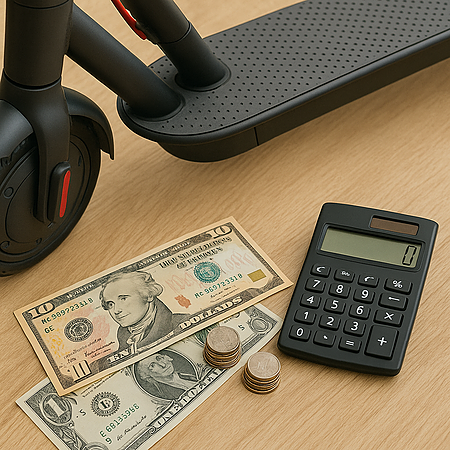Like most purchases, it depends. Electric scooters run anywhere from $200 for something basic to $7,000 for an ultra-premium model. The real question is figuring out what you actually need.
Based on scooters I’ve owned and what you’ll see most people riding around the city, the range can be narrowed down further to $400 and $2,200. That’s the sweet spot where you’re likely to find something that works well and lasts.
So what constitutes fair value? And what should you spend to get what you need without getting ripped off? This comprehensive guide breaks down electric scooter pricing across all categories, from budget-friendly options to high-performance models, while revealing the hidden costs that many first-time buyers overlook.
Electric Scooter Price Ranges
Scooters are relatively simple machines, so pricing mainly comes down to features and performance. This means scooters with similar features and performance typically cluster in the same price range. The table below breaks down the features you’d expect in each class.
Now, let’s break down the price clusters into finer detail, starting with the most basic machines and working our way up.
Budget Scooters/Entry Level ($200-$500)
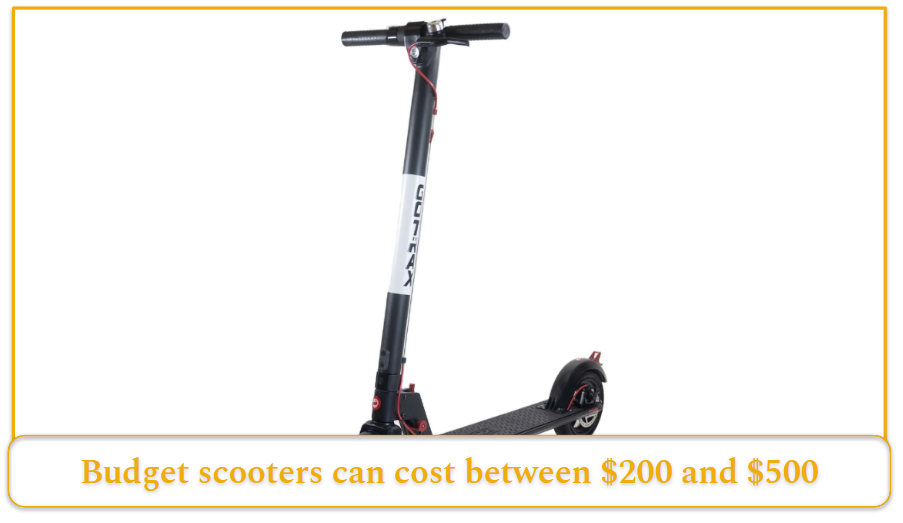
At the bottom of the food chain, we have entry-level electric scooters. These budget electric scooters give you basic features and basic performance for the basic price. Here’s what you get:
Performance
These affordable e-scooters deliver maximum speeds between 10-20 mph and provide a range of 10-15 miles per charge. They’re powered by small 250-350-watt motors, which is fine for flat pavement and lighter riders. But throw in some hills or add a heavier rider, and the limitations begin to show.
Additionally, they are powered by smaller batteries usually maxing out around 250 Wh. However, there’s an important reality check here: manufacturers have been known to overstate range by up to 30%, so if they advertise 15 miles, expect closer to 10 miles in real-world conditions with hills, stops, and varied riding styles.
Design and Build
Budget scooters stick to the basics. You get aerospace-grade aluminum frames, which sounds fancy but is really just standard practice these days, along with minimal or zero shock absorption, solid tires or small air-filled tubes, and a single motor setup.
They are designed to cater to riders weighing between 220-265 pounds, while the scooters themselves weigh between 25-35 pounds, making them reasonably portable for most users.
General Specifications
Features are bare-bones from simple display screens to basic lighting, and braking systems that need 20-30 feet to stop from 15 mph.
The deck sizes in this category are often smaller, usually around 6 inches wide, which feels cramped if you wear anything bigger than a size eight shoe.
Brand-name models come with 90-day to one-year warranties, while generic alternatives might offer limited warranty coverage or, worse, provide warranties they don’t honor when problems arise.
Potential Downsides
Build quality trade-offs become apparent quickly in this price range. For instance, plastic components tend to be flimsy and prone to breaking after minor falls.
The smaller tires and lack of suspension means every crack, bump, and painted line on the road translates directly to your feet and hands, which can become uncomfortable on longer rides.
This is compounded by the fact that the smaller frames do not provide the most ergonomic riding stance for adult riders.
Target Market for Budget Scooters
These budget scooters work perfectly for people who prioritize portability and affordability over raw performance such as students, apartment dwellers, or anyone seeking a simple last-mile solution for distances under 5 miles. If you’re connecting from public transit to your office, or just want something affordable and compact enough to store easily in a dorm room, this is an ideal choice.
Mid-Range Scooters ($500-$1,500)
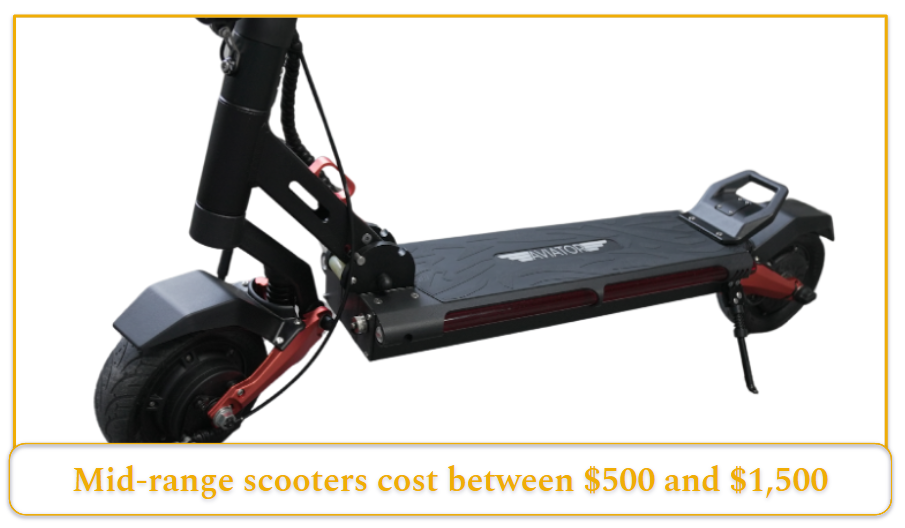
This is an intermediate class of scooters for riders who’ve outgrown the basic offerings of entry-level rides. These scooters deliver significantly improved performance and features but within a realistic budget. Here’s what to expect from mid-range scooters:
Performance
Motor power jumps to 350-800 W (older, priced-down models might even go to 1000 W), pushing cruise speeds into the low-to-mid 20s and unlocking confident hill climbs without a noticeable drop in speed and performance. A handful of commuters in this band hit 35 mph, though they sit at the top of the price bracket.
Range extends to 15-30 miles per charge thanks to larger batteries up to 400 Wh and more efficient power management systems.
Design and Build
Materials improve significantly, with higher-grade aluminum construction, some carbon fiber elements for weight reduction, and more durable plastic components that withstand regular use. Courtesy of better build quality, water resistance also starts to become standard, with many models achieving IPX4 ratings that protect against splashing water, though submersion should still be avoided.
Weight capacity expands to 220-330 pounds, but the scooters themselves get heavier at 35-55 pounds due to better components and bigger batteries. This weight increase should be a major consideration for commuters. At 40+ pounds, carrying these scooters becomes challenging for many people. The general rule suggests not purchasing a scooter exceeding 30% of your body weight if portability matters to your daily routine.
General Specifications
You get proper displays with smartphone connectivity, decent suspension front and rear, and 10-inch air-filled tires that don’t hate your spine. Premium models in this range might come with tubeless tire designs that reduce flat incidents.
Braking systems also become more sophisticated, incorporating drum and disc brakes alongside regenerative systems that deliver reduced stopping distances of about 15-20 feet from 15 mph.
Target Market for Mid-Range Scooters
This tier works for daily commuters covering 5-15 miles who’ve outgrown budget models. City commuters, weekend errand runners, and suburban riders dealing with hills all land here. They want something that folds into a trunk but feels solid at 15 mph, can handle small potholes, and lasts a full week of short trips on one charge. It’s the sweet spot for people upgrading from shared scooters or replacing short car trips with something electric.
Premium/ Performance Scooters ($1,500-$3,000)
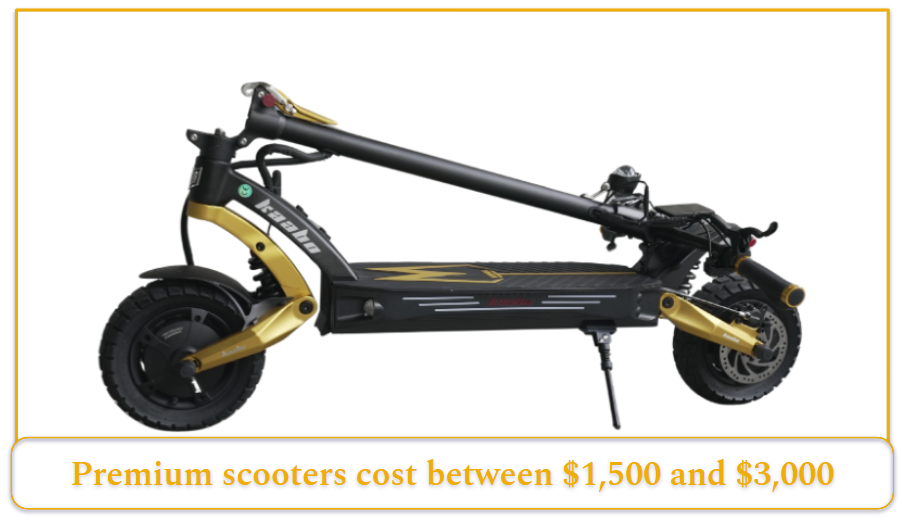
Premium scooters will cost you a pretty penny. However, they deliver performance that begins to rival motorized vehicles. Here’s what you’re paying for:
Performance
Performance scooters deliver tested top speeds of 25-40 mph. Most of them come with dual motors that facilitate quick acceleration and impressive performance on hilly terrain. Many also feature sine wave controllers to provide smooth acceleration and improved efficiency, eliminating the jerky power delivery common in cheaper models.
Range in this class extends to 25-45 miles per charge. And you start to see large, high-quality battery cells from established manufacturers like LG, Samsung, or Panasonic, which offer longer battery life and better energy efficiency compared to generic alternatives.
Design and Build
Construction utilizes premium materials including reinforced aluminum alloys, carbon fiber components for critical stress points, and fewer plastic components. This more intricate construction achieves high dust and water resistance ratings (often IPX5 or better), meaning you can ride confidently in lighter rain.
Some models include optional seats for extended riding comfort during longer journeys. Deck sizes expand significantly in this category, often reaching 18+ inches in length and 7+ inches in width, providing plenty of room for larger feet and allowing riders to shift positions during longer rides for comfort. Weight capacity also increases to 265-350 pounds, while the scooters themselves weigh 50-75 pounds.
General Specifications
This price category showcases the best of scooter engineering through integrated smart displays with comprehensive smartphone connectivity, GPS tracking, theft protection systems, high-quality suspension systems (often hydraulic or coil-over designs), specialized tires (including hybrid compounds, self-sealing technology, and off-road variants), and dual motor configurations.
The stopping power in this category becomes impressive, with hydraulic disc brakes and dual braking systems achieving stopping distances under 15 feet from 15 mph. This braking distance is on motorcycle level performance. Turn signals, advanced lighting systems, and even features like traction control start appearing in the upper end of this range.
Potential Tradeoffs
The increased performance comes with portability trade-offs. At 60+ pounds, these scooters require careful consideration of your storage situation. Do you have ground-floor parking? Are there elevators at your destinations? Can you physically maneuver 60+ pounds up stairs if necessary?
Target Market for Performance Scooters
These premium electric scooters are ideal for performance enthusiasts, long-distance riders covering 15+ miles daily, technology lovers who want cutting-edge features, serious commuters who rely on their scooter as primary transportation, and riders who demand the best possible ride quality.
Ultra-Premium/Luxury Scooters ($3,000+)
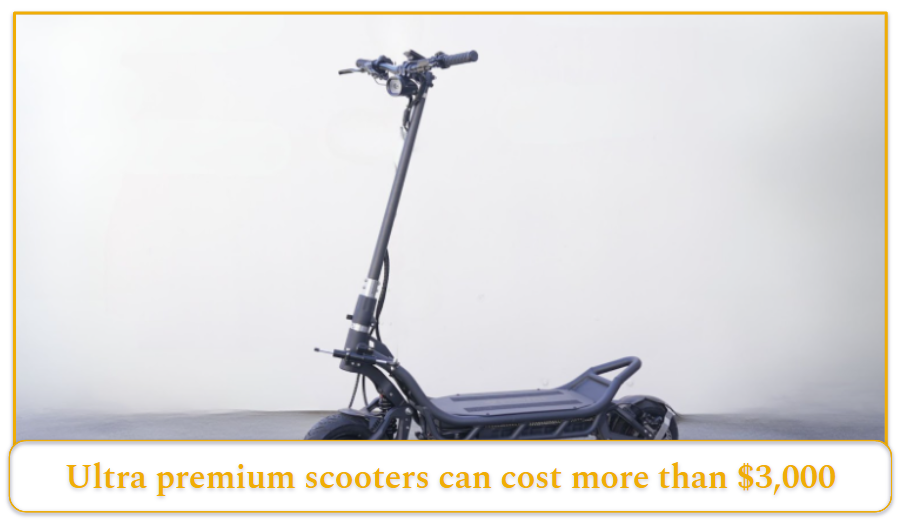
Ultra-premium scooters represent the pinnacle of electric scooter technology. Not many people will spend this much money on an electric scooter. However, those who buy them consider the following privileges of owning one:
Performance
These are the scooters that make headlines, especially in competitive riding spaces. You have models reaching speeds up to 80 mph with rapid acceleration, sometimes going from 0-30 mph in under 4 seconds.
Maximum power output gets insane, with some pushing over 10,000 watts, which you should absolutely avoid unless you’re experienced or have excellent health insurance.
Range, on the other hand, can exceed 40 miles per charge, powered by massive battery systems often exceeding 1,500 watt-hours and carrying the highest-grade cells available.
Design and Build
Designers go all out in this category. They experiment with all kinds of construction material including full carbon fiber frames, unibody, single-welded frames, and even experimenting with materials like chrome. Their features are almost always branded or custom developed for the particular models.
Majority weigh 75+ pounds and can reach 100+ pounds for the most extreme models. This means they require ground-level storage, making portability essentially impossible for most users. On the plus side, weight capacity often exceeds 300 pounds, which covers most adult riders.
Due to their premium positioning and often limited production runs, these models frequently include extended warranties (sometimes up to 2-3 years), payment plan options to spread the substantial cost, and white-glove service including delivery and setup. Many ultra-premium models are available only on pre-order, with delivery times extending 6-12 months due to small production volumes and high demand.
General Specifications
These scooters incorporate cutting-edge technology including traction control systems, assisted braking with ABS-like functionality, top-level hydraulic suspension systems with adjustable rebound and compression, advanced lighting arrays that rival automotive systems, steering dampers for high-speed stability, and extensive customization options through sophisticated smartphone applications.
Target Market for Luxury Scooters
Ultra-premium scooters are ideal for speed enthusiasts seeking motorcycle-like performance, extreme commuters covering 20+ miles daily, sporting riders who treat scooters as recreational vehicles, collectors who appreciate cutting-edge technology, and business or commercial applications where performance justifies the investment. For casual city hops, they are overkill.
Factors Influencing Electric Scooter Prices
Electric scooter pricing varies wildly because of the complex mix of components, materials, features, and build quality that determine overall performance and reliability. The following is a breakdown of how specific features affect cost.
Motors
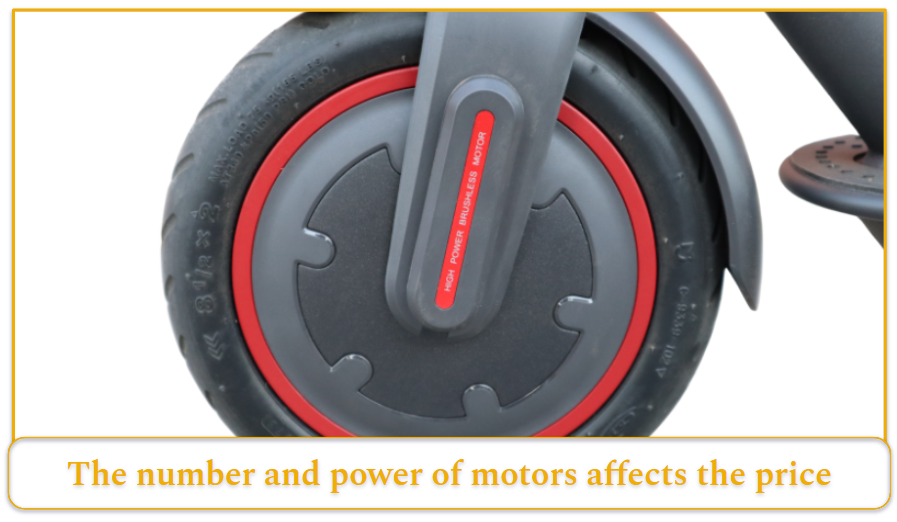
The number and power of motors greatly affect pricing and represent one of the most significant cost factors.
- Basic scooters use single 250W motors that work fine on flat ground but struggle on anything resembling a hill.
- Mid-range models often include 350- 500W motors capable of handling moderate hills.
- High-end models may include dual motors producing 1,000+ W each, providing exceptional hill-climbing ability and acceleration that rivals motorcycles.
The jump from single to dual motor configurations typically adds $300-800 to manufacturing costs. And even though many riders are not sure how motor ratings affect performance, they will comfortably add a couple hundred dollars to their budget to get the scooter with the bigger motors. Most manufacturers plaster the number in the largest possible font on the packaging–as a way of ‘justifying’ the cost.
Battery Technology
Batteries account for 30-40% of total manufacturing cost, and this is where manufacturers either deliver or completely screw you over. Premium models use branded cells from manufacturers like LG, Samsung, or Panasonic, which offer better longevity, more consistent power delivery, and superior safety characteristics compared to generic alternatives.
Battery capacity, measured in watt-hours (Wh), directly correlates with both range and price. A small 144Wh battery might provide 4-8 miles of real-world range, while massive 5,040Wh systems can exceed 80 miles. Additionally, larger batteries require more sophisticated management systems, cooling, and structural support, driving costs even higher.
That said, battery replacement also introduces a long-term cost consideration. Quality batteries last 300-500 charging cycles (about 2-4 years), while budget batteries may degrade in half that time. Replacement costs range from $100-200 for budget scooters to $400-800+ for premium models, representing 25-40% of the original scooter price.
Construction Materials
Frame materials impact both performance and cost. Basic aluminum alloys provide adequate strength at low cost, while aerospace-grade aluminum offers superior strength-to-weight ratios. Carbon fiber components, increasingly common in more expensive models, provide exceptional strength with minimal weight but command premium pricing due to manufacturing complexity.
Magnesium alloy is the lightest option but costs even more than carbon fiber. And in 2023, a major electric scooter brand released a full-chrome scooter, which got cancelled at pre-production due to high cost implications.
Suspension Systems
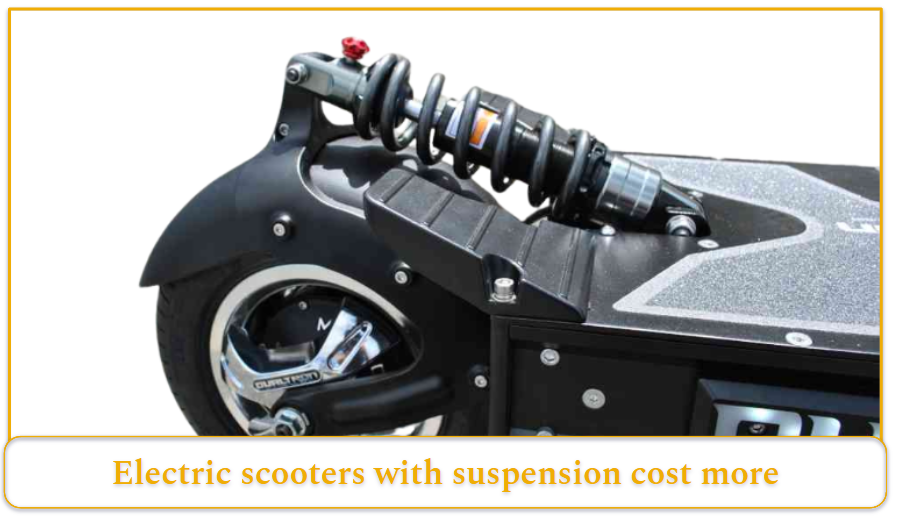
Electric scooters with suspension will cost more.
Basic spring suspension is the cheapest option on scooters. It provides limited damping, but it’s better than nothing, which is what you get on budget models.
As you move up the price ladder, advanced hydraulic or rubber suspension systems, sometimes with adjustability for different rider weights and preferences, transform ride quality but significantly increase manufacturing costs.
The difference becomes apparent immediately when riding. Without suspension, especially with solid tires, every crack and obstacle on the road creates jarring impacts. Quality suspension systems smooth these irregularities, reducing fatigue and improving control.
Tires
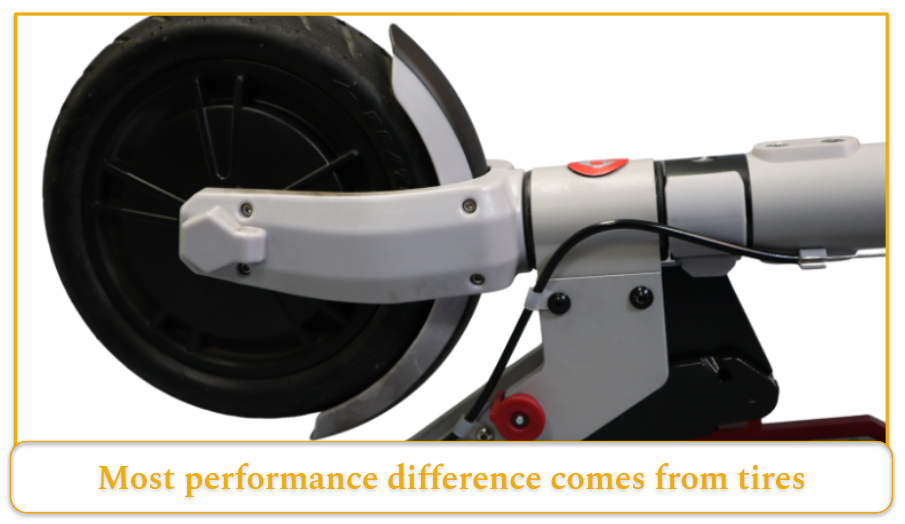
Tire types create one of the most noticeable performance differences. Solid tires eliminate flat tire concerns but provide harsh ride quality and poor traction, especially in wet conditions. Air-filled tires offer superior comfort and grip but require maintenance and are susceptible to punctures.
However, more premium models rely on tubeless designs to reduce flat tire incidents while maintaining air-filled tire benefits. At the same time, specialized tires like puncture-proof, self-healing, or off-road compounds also command premium pricing due to advanced materials and manufacturing processes.
Tire size also affects both performance and cost. Larger tires (10+ inches) roll over obstacles more easily and provide better stability but increase weight and manufacturing costs. Smaller tires (8.5 inches or less) enhance portability but compromise ride quality and high-speed stability.
Braking Systems
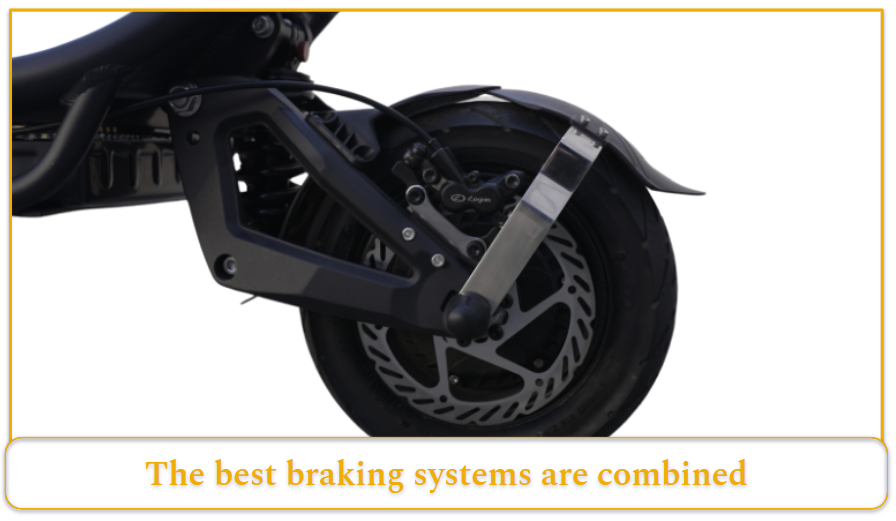
Basic foot brakes, where you stomp on the rear fender to stop, are the cheapest option and provide minimal stopping power. We’re talking 30+ feet stopping distances from 15 mph.
Next on the list is electronic regenerative braking, which appears on almost all modern scooters. It works by reversing the motor to slow you down while feeding power back to the battery. It offers some stopping power and extends range, but typically still requires 30-40 feet for emergency stops.
Mechanical disc brakes are more expensive but deliver the best stopping power at 15-20 feet. Drum brakes are cheaper but less effective than disc brakes, which tend to be the premium option.
The best systems combine mechanical and electronic braking for maximum effectiveness, though you’ll pay for it.
Smart Integration
More integration equals higher prices.
Modern scooters increasingly include smartphone connectivity, GPS tracking, anti-theft systems, customizable riding modes, and remote diagnostics. These features require additional sensors, processors, software development, and ongoing support, significantly increasing costs. However, they provide substantial value through theft deterrence, performance monitoring, and convenience features.
Weather Protection
IP ratings indicate protection against dust and water intrusion, which is important for year-round riding. Higher ratings require better sealing, specialized components, and rigorous testing, all increasing manufacturing costs. IPX4 protects against splashing water, while IP65+ allows riding in heavy rain and even hosing down for cleaning.
Ergonomics and Design
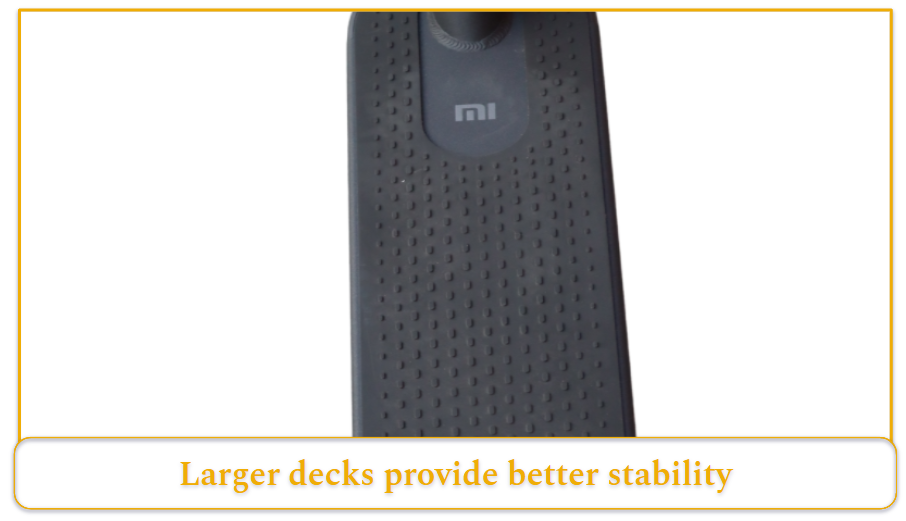
Deck size and shape affect both comfort and manufacturing complexity. Larger decks (18+ inches long, 7+ inches wide) provide better stability and allow foot repositioning during longer rides but require more materials and engineering.
Additionally, folding mechanisms are essential for portability, but they add complexity and potential failure points. Quality folding systems that maintain structural integrity under stress will lead to higher manufacturing costs.
Brand/ Manufacturing Standards
Rigorous quality control, testing protocols, and manufacturing standards increase costs but improve reliability and safety. Premium brands invest heavily in these areas, conducting extensive real-world testing, stress analysis, and component validation. These investments are reflected in pricing but result in products that perform consistently and safely over extended periods.
Support Infrastructure
Comprehensive warranties, responsive customer service, readily available replacement parts, and established service networks require significant company investment.
Brands offering 2+ year warranties with actual support (rather than just paperwork) must account for these costs in their pricing.
Companies that disappear when problems arise offer lower prices initially but leave customers stranded when issues develop.
Research and Development
Innovative features, improved efficiency, and cutting-edge technology require extensive R&D investment. Companies pushing the boundaries of performance, safety, or convenience must recoup these development costs through product pricing.
Generic manufacturers copying existing designs avoid these costs but offer no innovation or advancement.
Additional Costs of Owning an Electric Scooter
Your scooter purchase price is just the beginning. There are ongoing costs that affect total ownership and should factor into your buying decision. These Include:
Charging Costs
Electricity costs for charging are minimal but depend on your usage and local rates. A typical scooter with a 500Wh battery costs about $0.06-$0.15 per full charge, based on average US electricity rates of $0.12-$0.30 per kWh.
If you’re commuting daily and charging every night, you’re looking at $20-$50 annually in electricity costs. Even the biggest battery systems rarely exceed $100 per year in charging costs, making electric scooters remarkably cheap to operate.
Maintenance and Repairs
Basic stuff you can do yourself: check tire pressure monthly if you’ve got air tires, adjust brakes, clean the thing, tighten bolts. Most people can handle this with whatever tools they’ve got lying around.
But then you’ve got the bigger stuff.
- Tires wear out, which might cost you about $30-100 per tire.
- Brake pads need replacing — $20-50.
- Inner tubes, if you’ve got pneumatic tires — $10-20.
- Occasional cable replacements — $15-30.
- Professional servicing is recommended annually for heavily used scooters and will generally cost you about $50-150 depending on the service provider and required work.
Component replacement represents the largest maintenance expense category. Motors can fail, especially in budget scooters or heavily used models, requiring replacement costs of $100-500 depending on scooter value. Controllers, which manage power delivery, can also fail and cost $75-300 to replace. Structural damage from accidents can result in frame repairs(not advisable) or replacement parts costing hundreds of dollars.
Battery Replacement
Battery replacement is the most significant long-term cost and usually determines whether a scooter remains economically viable. Most batteries maintain optimal performance for 300-500 charging cycles, which is about 2-4 years of regular use. Premium batteries with high-quality cells can exceed 1,000 cycles, while budget batteries might degrade significantly faster.
Replacement costs vary greatly based on scooter class and battery technology. Budget scooter batteries cost $100-200 to replace, mid-range models require $200-400, while premium scooters can demand $400-800+ for new battery systems. These costs represent 25-40% of the original scooter price, making battery longevity a crucial consideration for long-term value.
Battery care significantly affects longevity, while proper charging habits like avoiding complete discharge, charging regularly, and storing at appropriate temperatures can extend battery life substantially. In the meantime, poor practices like letting batteries drain completely or exposing them to extreme temperatures can halve their useful life.
Safety Equipment and Accessories
Safety gear is both a practical necessity and often a legal requirement across the US. Essential items include helmets ($30-$150 depending on quality and certification), additional lighting for enhanced visibility ($20-$80), and reflective clothing ($15-$50) for low-light riding.
Quality helmets certified for bicycle or motorcycle use actually protect your head. Tempting to go cheap but think about medical bills from head injuries versus spending a bit more upfront.
Optional accessories enhance functionality and security but add to overall costs. These include:
- Locks: $25-$100
- Carrying bags: $30-$80
- Phone mounts: $15-$40.
Lastly, insurance is not universally required but provides valuable protection against theft, damage, and liability claims. Annual premiums range from $100-$300 depending on scooter value, coverage level, and local risk factors.
Legal and Regulatory Costs
When it comes to legal costs, electric scooter riders are mostly on the lucky side. Most states don’t require registration, insurance, or driving licenses for electric scooters, so your cost here is basically zero.
But of course, there are exceptions because there always are. A few states like Hawaii require you to register your scooter, so you’ll be down some cash there ($30-50). Some states also lump scooters in with other vehicles like mopeds, which means you might have to cough up registration and licensing fees. But again, that’s pretty rare.
Scooter legislation remains unclear in many states, making it surprisingly easy to unintentionally break rules you weren’t aware existed. You can get caught up in violations for riding in restricted areas, going over speed limits, or missing required safety equipment. Fines usually run fifty to five hundred bucks, depending on the violation and local enforcement policies.


